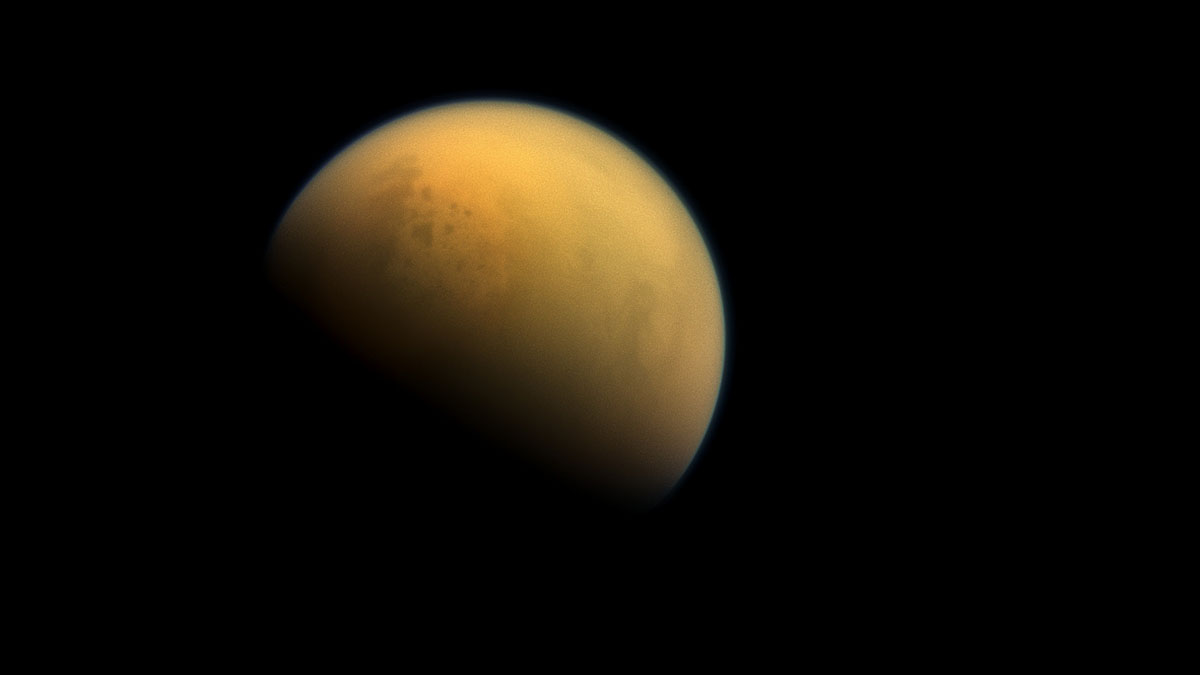the media finds life on titan. sort of…

Around the web, headlines are buzzing about alleged evidence for life on Saturn’s biggest moon Titan, citing a paper which noted a suspicious lack of hydrogen build-up in the lower atmosphere and listing among many a mundane explanation, the possibility of methane-based life. Now, while on this blog I discussed that it’s not impossible to have living things in temperatures of nearly -300°F and using exotic liquids the way life on our planet uses water, and pointed to academic work about what could be living on Titan, I have to say that the media coverage of these findings has been vastly overblown and we’re still very far from actually proving that life exists on the small, frigid world. The only way we’ll truly know is to once again visit Titan and take samples from its sediment, its ices, and especially, it’s lakes of liquid methane to look for something like cryobacteria.
Here’s the deal. As reported by Ars Technica in a typical example of this item’s write-ups, there’s some very exotic organic chemistry going on in Titan’s thick atmosphere, forming complex hydrocarbons which are then hit by UV rays from the Sun, releasing hydrogen. Quite a bit of that hydrogen should be slowly sinking closer to the surface and accumulating there. And yet, that doesn’t seem to be the case. When looking at their options, the scientists listed the potential for microorganisms which use liquid methane as a solvent in their bodies in lieu of water because they could breathe hydrogen gas and use it to power life sustaining chemical reactions in their cells, a lot like Earth’s life does with oxygen. Even more interesting is that in the upper layers of Titan’s atmosphere, acetylene should be plentiful and the same hypothetical cryo-microbes breathing the hydrogen could use acetylene as a source of carbon for the second half of their vital energy production and leaving little of it lingering in the moons air. And wouldn’t you know it, Titan seems to have a shortage of acetylene too.
Ok, so far so good, right? If this scenario is true, there should be colonies of bacteria on Titan benefiting from the atmospheric processes and helping us prove that the universe as a whole is probably brimming with life. But remember the two mentions that life was just one of the several possible answers to the lack of hydrogen and acetylene build-up? Yeah, Ars Technica takes note of this too. In the next to last and last paragraphs…
Two chemical enigmas certainly don’t constitute life, and the authors of the latter paper provide a variety of ways to account for the acetylene shortage that don’t involve an organism. […] Scientists are a cautious bunch, and it’s likely that these results will remain in limbo for a while.
In other words, scientists provide a wide list of explanations for what could be happening to the hydrogen and acetylene in Titan’s atmosphere but none of those deserve any explanation or elaboration. Instead, the media is going to focus on the potential of methane-based life which gets a brief mention in one of the papers being cited, mostly as a mention of a work done by an astrobiologist who came up with an estimate for a minimum concentration of hydrogen needed for exotic living things. By the way, in case you’re wondering, the paper was published in March of this year without so much as a mention until now, when someone decided to attract an audience with something more than the typical recycled story about potential alien life. This coverage is yet another demonstration of the lack of regard for scientific accuracy in the news and how perfectly valid science that looks at alien worlds for signs of respiration from alien flora and fauna is being used to fuel an overhyped on-demand sensation. We’ve had the exact same thing happening with The Sun in a story about Mars and loud announcements which recycled a speculative press release about methane plumes on the Red Planet made last year and signifying very little empirical proof of anything, much less aliens.
When we see just how much the media exaggerates or just plain fabricates science stories, then refuses to acknowledge its mistakes and give actual scientists a chance to correct the facts, it paints scientists as just a bunch of dreamers in lab coats playing guessing games, fuels denialist movements, and undermines public opinion of scientists and the scientific process. Life on Titan is possible and it’s definitely a-ok to explore how it may exist. But it’s definitely not kosher to splatter sensationalism and reporters’ sloppy guesswork designed simply to attract attention across, then present the resulting mess as the work of scientists who have nothing to do with the media hype manufactured in an editorial meeting. And for the same reasons, any scientist who turns into a media hound whose only goal is to attract the press’ spotlight deserves to be rebuked just as harshly as any clueless reporter for littering the news with unsubstantiated and grandiose claims.
See: Strobel, D. (2010). Molecular hydrogen in Titan’s atmosphere: Implications of the measured tropospheric and thermospheric mole fractions Icarus DOI: 10.1016/j.icarus.2010.03.003





